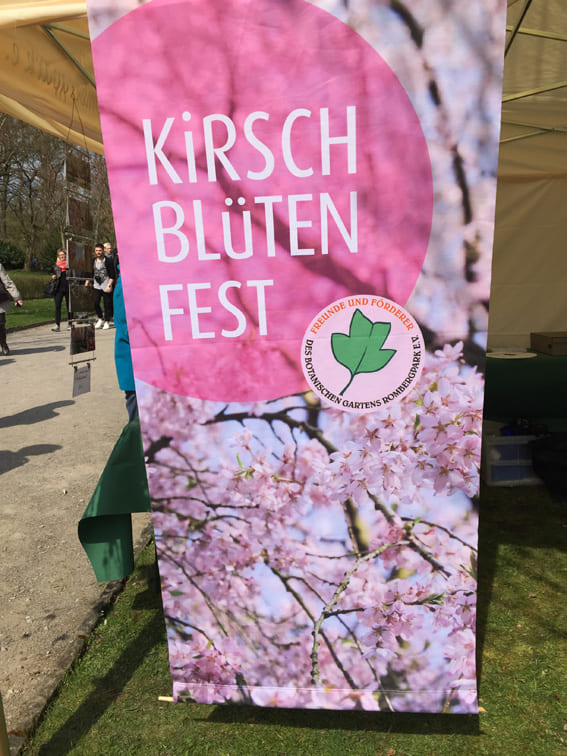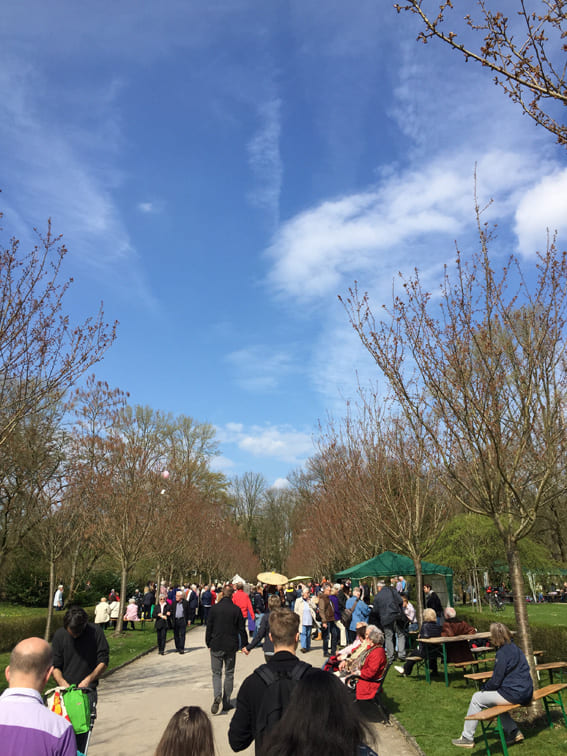The last Sunday in March sees Germany change to summer time at 1am. Until this point, dusk falls between 5 and 6pm. But once summer time comes in, the daylight hours get longer and longer, and you suddenly find it’s still light around 8pm.
In the smile of the sunshine, the flowers begin to open in unison, and you feel the coming of spring – which can only make you feel cheerful!
Anyway, about 70 km (thus a one-hour car drive) from Düsseldorf, you can find the Rombergpark Botanical Garden in Dortmund. April 10th 2016 saw this garden host its first ever Cherry Blossom Festival (Kirschblütenfest). Two hundred cherry trees were planted there last year, taking the grand total to 280 - one of the largest collection of its kind in NRW (Nordrhein-Westfalen).

Cherry blossoms suddenly bloom into beauty, only to see their beautiful petals fall and scatter to earth in a mere week. It is this decisiveness of action, and grace, which makes us picture the life of the samurai, and puts cherry blossom level with the chrysanthemum; loved as if it were Japan’s national flower. And so, to add further colour to the festival direct from Japan, “Land of the Cherry Blossom,” we went along to take part in a German-Japanese cultural exchange. The day saw a taiko kids’ group, flower arrangement and a kimono show offered up by the people of Düsseldorf, in addition to calligraphy and origami introductory events – literally all kinds of Japanese culture.
The Main Cherry Blossom Street
Unfortunately the cherry trees were not yet in bloom. But when both sides of the street are shining with fully-bloomed cherry blossom, it seems you can enjoy a Japanese-style spring picnic!

Taiko Kids
The high-powered taiko performance from the kids group, built around the children of Düsseldorf, reverberated throughout the park!

Kimono Show
At 2:30pm, on the artificial lawn situated just 20 meters in front of the cafe, we could witness a kimono show at very close quarters. Here, we were introduced to komon fine pattern kimonos, kids’ kimonos, homon-gi visiting kimonos for women, kurotomesode black ceremonial kimonos, hakama, furisode long-sleeved kimonos – a multitude of traditional attire for various places and occasions. The explanation – and demonstration – of how to tie up a 4-meter-long obi belt in a variety of knots doubtless added to the charm of the Japanese kimono.
Amid a variety of kiosks on the promenade – and in the bright, warm sunshine – a large number of locals enjoyed the festival fun while going for a stroll.

And so, the festival made me realize anew how Japanese people living overseas can be appreciated as a good source of Japanese culture. I therefore came away hoping to deepen German-Japanese cultural exchanges through activities which both promote spiritual happiness and spread the message of peace.
 Cherry blossoms suddenly bloom into beauty, only to see their beautiful petals fall and scatter to earth in a mere week. It is this decisiveness of action, and grace, which makes us picture the life of the samurai, and puts cherry blossom level with the chrysanthemum; loved as if it were Japan’s national flower. And so, to add further colour to the festival direct from Japan, “Land of the Cherry Blossom,” we went along to take part in a German-Japanese cultural exchange. The day saw a taiko kids’ group, flower arrangement and a kimono show offered up by the people of Düsseldorf, in addition to calligraphy and origami introductory events – literally all kinds of Japanese culture.
Cherry blossoms suddenly bloom into beauty, only to see their beautiful petals fall and scatter to earth in a mere week. It is this decisiveness of action, and grace, which makes us picture the life of the samurai, and puts cherry blossom level with the chrysanthemum; loved as if it were Japan’s national flower. And so, to add further colour to the festival direct from Japan, “Land of the Cherry Blossom,” we went along to take part in a German-Japanese cultural exchange. The day saw a taiko kids’ group, flower arrangement and a kimono show offered up by the people of Düsseldorf, in addition to calligraphy and origami introductory events – literally all kinds of Japanese culture.




 And so, the festival made me realize anew how Japanese people living overseas can be appreciated as a good source of Japanese culture. I therefore came away hoping to deepen German-Japanese cultural exchanges through activities which both promote spiritual happiness and spread the message of peace.
And so, the festival made me realize anew how Japanese people living overseas can be appreciated as a good source of Japanese culture. I therefore came away hoping to deepen German-Japanese cultural exchanges through activities which both promote spiritual happiness and spread the message of peace.






























































